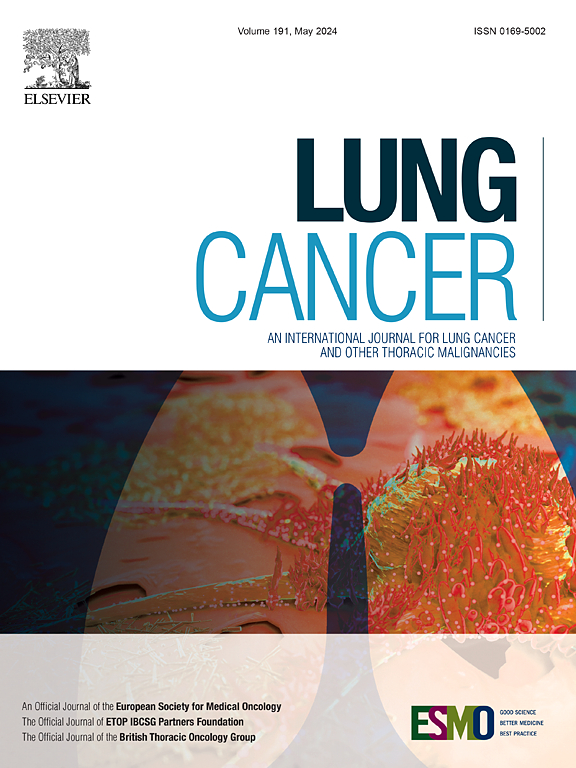Identification of poor prognostic factors using circulating extracellular vesicles in durvalumab consolidation therapy for locally advanced non-small cell lung cancer
IF 4.4
2区 医学
Q1 ONCOLOGY
引用次数: 0
Abstract
Background
The risk factors associated with treatment resistance to consolidation durvalumab following chemoradiotherapy (CRT) for locally advanced non-small cell lung cancer (NSCLC) have not been well established.
Methods
Extracellular vesicles (EVs) were isolated from the pretreatment serum of 73 patients treated with consolidation durvalumab. Isolation was performed using CD9/CD63 antibodies, and EV proteins were identified using liquid chromatography-tandem mass spectrometry (LC-MS). The relationship between the expression of these proteins and progression-free survival (PFS) after durvalumab initiation was analyzed.
Results
The median PFS was not reached (NR) (95 % confidence interval [CI], 17.2 months-NR), and the 24-month PFS rate was 54.7 % (95 % CI, 44.4–67.4). Proteomic analysis of circulating EVs identified RPS27A, SAA1, and S100A7 as the primary candidate biomarkers. Notably, patients with high RPS27A expression exhibited a significantly shorter PFS compared with those with low expression; hazard ratio (HR) 2.93 (95 % CI: 1.48–5.79), P = 0.002. Similarly, high SAA1 expression was associated with a shorter PFS; HR 2.94 (95 % CI: 1.37–6.30), P = 0.006. High S100A7 expression also correlated with poorer outcomes; HR 2.94 (95 % CI: 1.43–6.04), P = 0.003. In multivariate analysis, a high expression level of RPS27A was identified as an independent predictor of poor PFS; HR 2.29 (95 % CI: 1.01–5.17), P = 0.047. Multivariate receiver operating characteristic (ROC) analysis incorporating these three proteins yielded an area under the curve (AUC) of 0.71 (95 % CI: 0.59–0.83).
Conclusion
This study demonstrated favorable PFS outcomes in patients receiving durvalumab consolidation therapy. Circulating EV proteomic analysis identified RPS27A, SAA1, and S100A7, particularly RPS27A, as potential biomarkers for predicting resistance to durvalumab.
循环细胞外囊泡在durvalumab巩固治疗局部晚期非小细胞肺癌中的不良预后因素鉴定
背景:局部晚期非小细胞肺癌(NSCLC)放化疗(CRT)后巩固durvalumab治疗耐药相关的危险因素尚未得到很好的确定。方法从73例杜伐单抗治疗患者的预处理血清中分离出6个细胞囊泡(EVs)。采用CD9/CD63抗体进行分离,采用液相色谱-串联质谱法(LC-MS)鉴定EV蛋白。分析了这些蛋白的表达与杜伐单抗启动后的无进展生存期(PFS)之间的关系。结果中位PFS未达到(NR)(95%置信区间[CI], 17.2个月-NR), 24个月PFS率为54.7% (95% CI, 44.4-67.4)。循环ev的蛋白质组学分析确定RPS27A、SAA1和S100A7为主要候选生物标志物。值得注意的是,RPS27A高表达患者的PFS明显短于低表达患者;风险比(人力资源)2.93(95%置信区间:1.48—-5.79),P = 0.002。同样,高SAA1表达与较短的PFS相关;Hr 2.94 (95% ci: 1.37 ~ 6.30), p = 0.006。S100A7高表达也与预后较差相关;Hr 2.94 (95% ci: 1.43 ~ 6.04), p = 0.003。在多变量分析中,RPS27A的高表达水平被确定为不良PFS的独立预测因子;Hr 2.29 (95% ci: 1.01-5.17), p = 0.047。纳入这三种蛋白的多变量受试者工作特征(ROC)分析得出曲线下面积(AUC)为0.71 (95% CI: 0.59-0.83)。结论:该研究表明,接受杜伐单抗巩固治疗的患者PFS预后良好。循环EV蛋白质组学分析发现,RPS27A、SAA1和S100A7,尤其是RPS27A,是预测durvalumab耐药的潜在生物标志物。
本文章由计算机程序翻译,如有差异,请以英文原文为准。
求助全文
约1分钟内获得全文
求助全文
来源期刊

Lung Cancer
医学-呼吸系统
CiteScore
9.40
自引率
3.80%
发文量
407
审稿时长
25 days
期刊介绍:
Lung Cancer is an international publication covering the clinical, translational and basic science of malignancies of the lung and chest region.Original research articles, early reports, review articles, editorials and correspondence covering the prevention, epidemiology and etiology, basic biology, pathology, clinical assessment, surgery, chemotherapy, radiotherapy, combined treatment modalities, other treatment modalities and outcomes of lung cancer are welcome.
 求助内容:
求助内容: 应助结果提醒方式:
应助结果提醒方式:


